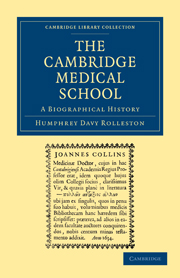Book contents
- Frontmatter
- Contents
- List of Plates
- Preface
- I The Medical School
- II Department of Anatomy
- III Department of Physiology
- IV Department of Biochemistry
- V Department of Experimental Psychology
- VI Department of Pathology
- VII Department of the Quick Chair of Biology
- VIII The Regius Chair of Physic
- IX John Caius
- X The Downing Chair of Medicine
- XI The Linacre Lectureship in Physic
- XII The Chair of Surgery
- Index of Persons
- Index of Subjects
- Plate section
VI - Department of Pathology
Published online by Cambridge University Press: 07 September 2010
- Frontmatter
- Contents
- List of Plates
- Preface
- I The Medical School
- II Department of Anatomy
- III Department of Physiology
- IV Department of Biochemistry
- V Department of Experimental Psychology
- VI Department of Pathology
- VII Department of the Quick Chair of Biology
- VIII The Regius Chair of Physic
- IX John Caius
- X The Downing Chair of Medicine
- XI The Linacre Lectureship in Physic
- XII The Chair of Surgery
- Index of Persons
- Index of Subjects
- Plate section
Summary
HAVILAND, when Regius Professor, gave lectures on general and special pathology, Bond followed this example, and Bradbury as Linacre Lecturer announced lectures on pathology and morbid anatomy from the Easter term of 1873 until 1884; but Humphry's impressive teaching of surgical pathology in connection with clinical practice was the most valuable until a whole-time chair of pathology was established by Grace of December 6, 1883, after having been under consideration for some years. In 1879 a memorial was addressed to the University Commissioners signed by 138 graduates of the University “engaged in the study or practice of medicine” praying that, in the new Statutes for the University, provision might be made for an extension of the study of medical science, especially of pathology, medicine, and surgery. The science of pathology, the memorialists continued, had, “in addition to its value as an essential part of the complete study of Medicine, now attained such precision, proportions, and development that it seems to us fairly to demand recognition as one of the foremost subjects in the sphere of University work.”
The accommodation available for pathological work and teaching was very inadequate until 1904. C. S. Roy, the first professor, began with two small rooms on the third floor of Fawcett's building, over what was then the old Physiological Department, and lectured in the theatre of the old Anatomical School. During the academic years of 1885 and 1886 the numbers attending the classes were thirty-one and forty-six.
- Type
- Chapter
- Information
- The Cambridge Medical SchoolA Biographical History, pp. 102 - 116Publisher: Cambridge University PressPrint publication year: 2009First published in: 1932

